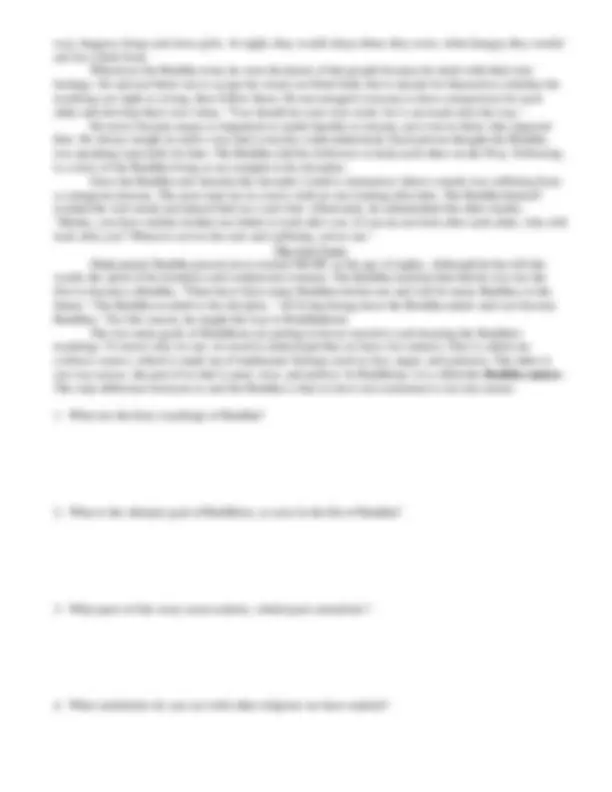



Study with the several resources on Docsity

Earn points by helping other students or get them with a premium plan


Prepare for your exams
Study with the several resources on Docsity

Earn points to download
Earn points by helping other students or get them with a premium plan
Community
Ask the community for help and clear up your study doubts
Discover the best universities in your country according to Docsity users
Free resources
Download our free guides on studying techniques, anxiety management strategies, and thesis advice from Docsity tutors
The Four Sights. Soon Siddhartha became disillusioned with the palace life and wanted to see the outside world. He made four trips outside the palace and ...
Typology: Study notes
1 / 2

This page cannot be seen from the preview
Don't miss anything!


Name: __________________________________________
Directions: For this assignment, you will read the following – then create a detailed drawing or diagram illustrating the life of Siddhartha (Buddha). Then answer the questions on this sheet, thinking about the larger ideas and beliefs of Buddhism.
Life in the Palace Buddhism is one of the major religions in the world. It began around 2,500 years ago in India when Siddhartha Gautama discovered how to bring happiness into the world. He was born around 566 BC, in the small kingdom of Kapilavastu. His father was King Suddhodana and his mother was Queen Maya. Soon after Prince Siddhartha was born, the wise men predicted that he would become a Buddha. When the king heard this, he was deeply disturbed, for he wanted his son to become a mighty ruler. He told Queen Maya, "I will make life in the palace so pleasant that our son will never want to leave." At the age of sixteen, Prince Siddhartha married a beautiful princess, Yasodhara. The king built them three palaces, one for each season, and lavished them with luxuries. They passed their days in enjoyment and never thought about life outside the palace. The Four Sights Soon Siddhartha became disillusioned with the palace life and wanted to see the outside world. He made four trips outside the palace and saw four things that changed his life. On the first three trips, he saw sickness, old age and death. He asked himself, "How can I enjoy a life of pleasure when there is so much suffering in the world?" On his fourth trip, he saw a wandering monk who had given up everything he owned to seek an end to suffering. "I shall be like him." Siddhartha thought. Renunciation Leaving his kingdom and loved ones behind, Siddhartha became a wandering monk. He cut off his hair to show that he had renounced the worldly lifestyle and called himself Gautama. He wore ragged robes and wandered from place to place. In his search for truth, he studied with the wisest teachers of his day. None of them knew how to end suffering, so he continued the search on his own. For six years he practiced severe asceticism (a life free from worldly pleasures) thinking this would lead him to enlightenment. He sat in meditation and ate only roots, leaves and fruit. At times he ate nothing. He could endure more hardships than anyone else, but this did not take him anywhere. He thought, "Neither my life of luxury in the palace nor my life as an ascetic in the forest is the way to freedom. Overdoing things can not lead to happiness." He began to eat nourishing food again and regained his strength. Enlightenment On a full-moon day in May, he sat under the Bodhi tree in deep meditation and said. "I will not leave this spot until I find an end to suffering." During the night, he was visited by Mara, the evil one, who tried to tempt him away from his virtuous path. First he sent his beautiful daughters to lure Gautama into pleasure. Next he sent bolts of lightning, wind and heavy rain. Last he sent his demonic armies with weapons and flaming rocks. One by one, Gautama met the armies and defeated them with his virtue. As the struggle ended, he realized the cause of suffering and how to remove it. He had gained the most supreme wisdom and understood things as they truly are. He became the Buddha, 'The Awakened One'. From then on, he was called Shakyamuni Buddha. The Buddha Teaches After his enlightenment, he went to the Deer Park near the holy city of Benares and shared his new understanding with five holy men. They understood immediately and became his disciples. This marked the beginning of the Buddhist community. For the next forty-five years, the Buddha and his disciples went from place to place in India spreading the Dharma, his teachings. Their compassion knew no bounds, they helped everyone along the
way, beggars, kings and slave girls. At night, they would sleep where they were; when hungry they would ask for a little food. Whenever the Buddha went, he won the hearts of the people because he dealt with their true feelings. He advised them not to accept his words on blind faith, but to decide for themselves whether his teachings are right or wrong, then follow them. He encouraged everyone to have compassion for each other and develop their own virtue, "You should do your own work, for I can teach only the way." He never became angry or impatient or spoke harshly to anyone, not even to those who opposed him. He always taught in such a way that everyone could understand. Each person thought the Buddha was speaking especially for him. The Buddha told his followers to help each other on the Way. Following is a story of the Buddha living as an example to his disciples. Once the Buddha and Ananda (his disciple) visited a monastery where a monk was suffering from a contagious disease. The poor man lay in a mess with no one looking after him. The Buddha himself washed the sick monk and placed him on a new bed. Afterwards, he admonished the other monks. "Monks, you have neither mother nor father to look after you. If you do not look after each other, who will look after you? Whoever serves the sick and suffering, serves me." The Last Years Shakyamuni Buddha passed away around 486 BC at the age of eighty. Although he has left the world, the spirit of his kindness and compassion remains. The Buddha realized that that he was not the first to become a Buddha. "There have been many Buddhas before me and will be many Buddhas in the future," The Buddha recalled to his disciples. "All living beings have the Buddha nature and can become Buddhas." For this reason, he taught the way to Buddhahood. The two main goals of Buddhism are getting to know ourselves and learning the Buddha's teachings. To know who we are, we need to understand that we have two natures. One is called our ordinary nature , which is made up of unpleasant feelings such as fear, anger, and jealousy. The other is our true nature, the part of us that is pure, wise, and perfect. In Buddhism, it is called the Buddha nature. The only difference between us and the Buddha is that we have not awakened to our true nature.